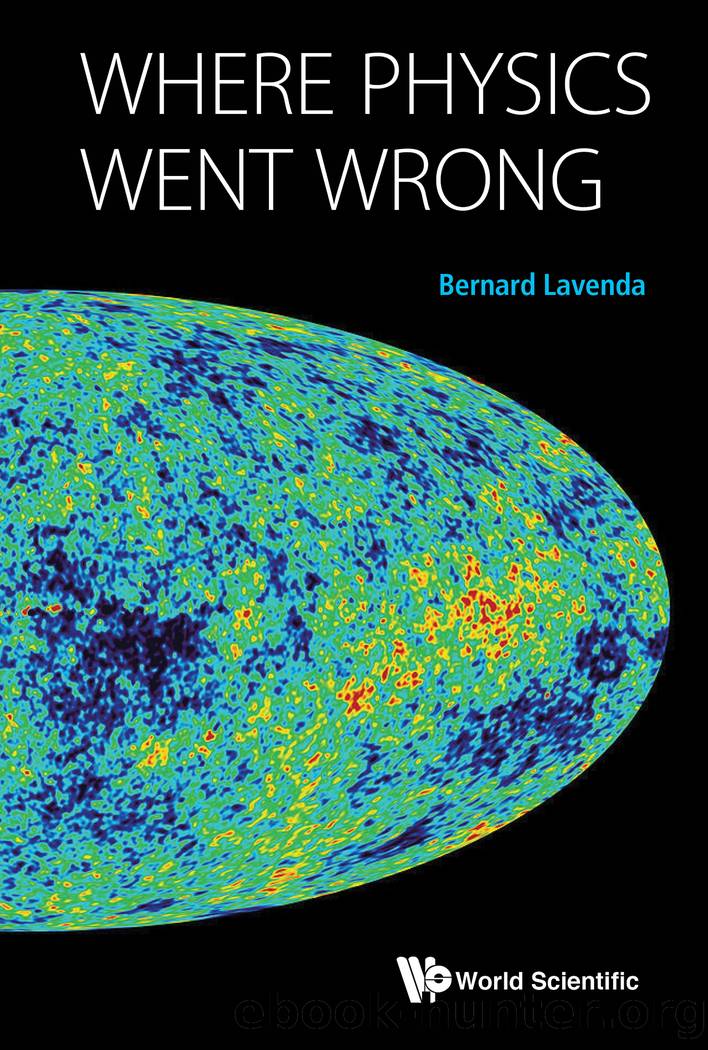Where physics went wrong by Bernard Lavenda

Author:Bernard Lavenda
Language: eng
Format: epub
ISBN: 9789814635240
Publisher: World Scientific Publishing Co. Pte. Ltd.
Published: 2015-06-14T16:00:00+00:00
3.4When Einstein meets Newton
Geometry is buried in the values of the metric tensor, gik. Even if Einstein’s equations (3.1) were beyond reproach, it would be necessary that the spatial metric reduce to the well-known forms of non-Euclidean geometries in the constant curvature limit, as, for example, in the case of the Beltrami metric, (3.6).
If Gauss’ theorem is to be used where do we take the surface of integration? It seems natural to use the surface of integration in the asymptotically flat region as r → ∞. This desire appears to be due to Einstein who, while outright rejecting absolute space, clings onto ferne massen (distant masses) in order that the gravitational field should be zero at infinity. Only a theory of absolute space (and time), like Newton’s, prescribes the constant of integration, while in Einstein’s theory the differential equation is prescribed and the constants of integration are relative.
In de Sitter’s [dS17] words: “The condition that the gravitational field shall be zero at infinity forms part of the conception of an absolute space, and in a theory of relativity it has no foundation.” de Sitter had higher hopes for Einstein’s general theory of relativity than what actually materialized.
This still leaves us with the inability to localize energy and momentum in space, and why such a localization should require [lle58] “the use of quasi-Galilean coordinates in which the components of the metric tensor, for increasing spatial distances, sufficiently rapidly converge towards the constant values of the special theory of relativity.” But Møller should have been aware that in the weak gravitational limit, gravity has become a physical field, so that it is difficult to believe that what was has been geometrized, has simply been transformed into a field of force merely by going to the asymptotic limit!
Where is the real seat of difficulty with Einstein’s theory? By setting the pseudo tensor equal to the extra piece in the definition of the covariant derivative we obtain a covariant conservation condition for the energy-matter tensor. But, it does not mean that the energy-matter tensor is a constant since it depends on some nonlocal translation law from some point on the surface S to some common reference point, which may be the center of mass. In other words, the sum of two tensors has no sense without the specification of the point in the curvilinear system to which we specify the sum of the tensors [Fol72].
General relativity is rather cavalier in eliminating divergences. The Lagrangian that Einstein started with was √ − g R. It contains both the first and second derivatives of the metric tensor. However, Einstein observed that all the second derivatives were contained in the total derivative of a certain quantity, ωi, whose divergence differs from Ricci’s scalar by a non-covariant density √ − g G,
Download
This site does not store any files on its server. We only index and link to content provided by other sites. Please contact the content providers to delete copyright contents if any and email us, we'll remove relevant links or contents immediately.
| Fluid Dynamics | Thermodynamics |
The Complete Stick Figure Physics Tutorials by Allen Sarah(6638)
Secrets of Antigravity Propulsion: Tesla, UFOs, and Classified Aerospace Technology by Ph.D. Paul A. Laviolette(3445)
Thing Explainer by Randall Munroe(3327)
The River of Consciousness by Oliver Sacks(2992)
The Order of Time by Carlo Rovelli(2714)
I Live in the Future & Here's How It Works by Nick Bilton(2524)
A Brief History of Time by Stephen Hawking(2473)
How To by Randall Munroe(2473)
The Great Unknown by Marcus du Sautoy(2185)
What If?: Serious Scientific Answers to Absurd Hypothetical Questions by Randall Munroe(2170)
Blockchain: Ultimate Step By Step Guide To Understanding Blockchain Technology, Bitcoin Creation, and the future of Money (Novice to Expert) by Keizer Söze(2136)
Midnight in Chernobyl by Adam Higginbotham(2077)
Networks: An Introduction by Newman Mark(1997)
The Meaning of it All by Richard Feynman(1909)
Easy Electronics by Charles Platt(1864)
The Tao of Physics by Fritjof Capra(1847)
When by Daniel H Pink(1776)
Midnight in Chernobyl: The Untold Story of the World's Greatest Nuclear Disaster by Adam Higginbotham(1774)
Introducing Relativity by Bruce Bassett(1754)
